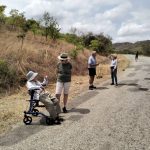TREE LIFE 520
DECEMBER 2023
FUTURE EVENTS
Saturday 2nd December 2023:- visit to the National Botanical Gardens. Meet at 8.3 0a.m. in the main car park and join Tony for 1½ hours in these fascinating gardens.
Sunday 17th December 2023/ Saturday 23rd :- no outing. We wish you all a Merry Christmas and enjoyable outings in 2024.
Saturday 6th January 2024:- visit to the National Botanical Gardens. Meet at 8.30 in the main car park.
Sunday 21st January 2024:- We plan to visit the Lake Chivero Arboretum. This was planted on Signal Hill in the 1950s and the last Tree Society visit was in September 2022. It is now time to see what changes the rain has made. After botanising we eat, drink and socialise so don’t forget your folding chairs and refreshments.
Directions: The Lake Chivero turnoff is on the left just past the Manyame Bridge on the Bulawayo Road. Follow the road as if you were going to the Lake Chivero Game Park. Once over the hill, there is a turning to the left at the bottom of the hill – it is signposted.
As we enter the rainy season, please check your email or WhatsApp for updates in the morning as outings may be postponed due to “inclement weather”.
REPORTS FROM PREVIOUS OUTINGS
NATIONAL BOTANICAL GARDEN OUTING 28TH OCTOBER 2023
By Tony Alegria, Mary Lovemore, Karl van Laeren, John Lawrence, Frances Morris, Peter Morris, and Ian Riddell with many thanks for photos extracted from the Zimbabwe Flora website (https://www.zimbabweflora.co.zw/)
I was asked to show members trees that the group going on the weekend tree outing to Kanyemba were likely to see. I was sent a list of possibilities and added a few of my own and plotted a route within the National Botanical Gardens.
I haven’t seen some of the trees on the list and the Brachystegia manga which was supposed to be in the gardens turned out to be an Afzelia quanzensis according to Chris Chipano!
Unfortunately:
the Acacia eriocarpa only had very young leaves so no prickles on the rachis but the stipules were obvious;
the Pteleopsis myrtifolia only had young leaves but it did have fruit from last year so there was no problem with that identification but we couldn’t find the Pteleopsis anisoptera nearby as none of the other trees had any fruit – just very young leaves;
the Pterocarpus lucens had no leaves or fruit at all; however there were some old pods under the tree;
the Commiphora ugogensis also had no leaves or fruit but was recognizable by its distinctive bark.
Tony
It was just like the days of yesteryear. On many occasions in the past, prior to venturing into new territory members of the Tree Society would gather at the National Botanic Garden to get a foretaste of which trees might be seen.
Members who were due to travel to Kanyemba gathered at the Botanic Gardens together with Tony, who had identified some of the trees and shrubs likely to be seen on the upcoming journey to Kanyemba and surrounds.
It promises to be an exciting adventure. The recent rain should have encouraged trees to flush or flower (or to be threatening either), The venue is new to many of the group and it will be hot!!!
Mary

Triplochiton zambesiacus

Strophanthus kombe

Balanites maughamii
Standing under the massive Balanites maughamii in the Botanical Gardens, admiring the “ink blot” footprint of the trunk, the “Y” thorns and then observing the fallen fruit sparked a discussion down memory lane. The use of the fruit’s flammable oil properties by Kim Damstra for his Halloween dinners then led to a discussion about decorating the Halloween table with Strophanthus kombe flowers and serving Triplochiton zambesiacus leaves as the wrapping for Dolmades for entrees. All three were recorded on our subsequent excursion to Kanyemba. Thank you Tony, for leading such a useful orientation walk for the “Kanyemba Crew”.
Frances
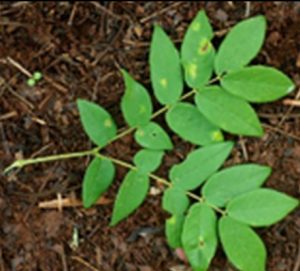
Xylia torreana
Tony did a great job of finding a number of the target species that we hope to see on the Kanyemba trip. It was great to meet Xylia torreana, the leaf with one pair of pinnae, flower like an Albizia and pods like a Baikiaea.

Brachystegia manga

Brachystegia allenii
I was pleased to see Brachystegia allenii which grows on the escarpment, with its soft, yellow young leaflets twisted relative to the plane at right angles to the main axis.
This will help to distinguish B. allenii from B. manga which we hope to see in the lowland miombo.
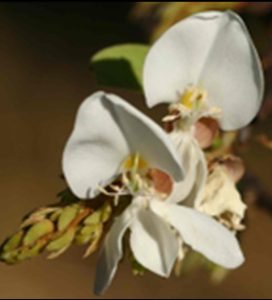
Baphia massaiensis

Schinziophyton rautanenii
I enjoyed becoming re-acquainted with Schinziophyton rautanenii which we saw at Mafungabusi earlier this year. Next to the Schinziophyton was a Baphia massaiensis, with exquisite, sweet-scented flowers.
Peter

The Zambezi Valley

The Rugby World Cup
The day provided a very exciting and nervous build-up for things to come on two fronts! For me, at least, it was preparation for a contest on two fronts, botanical and sport. It was a fine start to the final day in the Rugby World Cup 2023 encounter while we were preparing to meet many botanical unknowns in the Middle Zambezi Valley (MZV).
The heat of battle to come was a talking point, together with maximum temperatures for November in the MZV, with many predictions including the likelihood of rain and which unknown plants we would find. We were hoping that this introduction would improve our chances of a fruitful encounter.
As in any botanical walk this proved no exception included forays into trees that were eye catching but never a possible encounter in the MZV! All extra bonuses – a typical distraction on all our walks. The flowering of many Kanyemba trees added an extra layer of excitement to the walk.
Our planned trip will also include deviations to examine 200 million year old petrified conifers, archaeology in the form of salt mining and Zimbabwe style ruins, zoology , herpetology and some ornithological specials.
Karl
And finally
I do not usually attend the Botanic Gardens walks as I am not a “tree twitcher”, but Tony had offered to take us to view trees that we might see at Kanyemba, so I joined about 15 others to get my eye in. Sadly it was too early in the season for some of the species, as they only sported bare branches or unrecognisable leaf buds, but the two Balanites species that we are likely to encounter were in full leaf and easy to identify. Both have bifoliolate leaves, which is an unusual feature in trees, and both have stout, green spines, single in B. aegyptiaca and Y-tipped in B. maughamii. The other species that caught my eye was Baphia massaiensis, which sported the most beautiful white and pink petalled flowers; I hope we see some on our visit.
John
We were preparing as the rugby players were preparing to meet the unknown and
“proper prior preparation prevents poor performance”
was clearly a mutual objective. Tony Alegria put on one of the best tree walks I have ever done in the botanical gardens.
Karl
SATURDAY 4TH NOVEMBER 2023:- VISIT TO THE NATIONAL BOTANICAL GARDENS:
STORM DAMAGE
Text and photos by Tony Alegria
As a result of the Tree Society of Zimbabwe tree weekend outing to Kanyemba, kindly organized by Frances Morris, the majority of the regulars were away on the day. Only Dawn Siemers turned up for the monthly tree outing to the National Botanical Garden. It kind of seemed pointless having a botanizing walk about for two so we looked at the storm damage created some two weeks ago by the strong winds after we had the heaviest October rainfall since I began recording some 25 years ago.
I arrived early and had a good look at all the Christmas trees (Cypresses or Cupressus sp.) just outside the southern boundary of the Garden. I counted 15 branches or trunks that had either broken or snapped completely off. One of these boles had become impaled on the railing. The access road to the workshop runs along this boundary, so a huge tree-clearing exercise had to be undertaken to make the road passable. In the first photo below a couple of branches can be seen high up in the trees. I just wonder if these branches will ever be taken off!
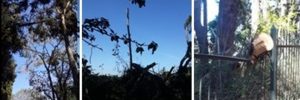
Broken off Cypresses branches and trunks
Recently I saw Chionanthus battiscombei, Water pock-ironwood in flower whilst still having fruit and went to see the biggest tree of this species and found quite a large branch had broken but was still hanging on!

Chionanthus battiscombei
Looking around there were some branches on various trees that had broken but were still hanging on and were made conspicuous by the leaves which had now turned brown. Funnily enough, the Christmas trees still looked green. The Albizia glaberrima. the Lowveld albizia, also had a couple of broken branches and had just finished flowering – this is another tree I have never seen in flower!

Khaya anthotheca
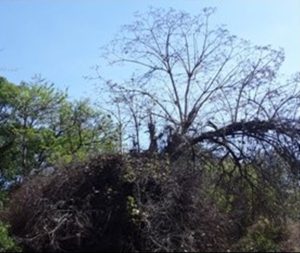
Cordia africana
Two trees that suffered pretty badly with many branches broken right off were a Cordia africana, the Large-leaved cordia and a Khaya anthotheca, the Red mahogany. It will be interesting to see how they recover.

Possible Senegalia hereroensis

Albizia harveyi supporting an Artabotrys brachypetalus
Then we came across a tree that had been blown over, this was an Albizia harveyi the Sickle-leaved albizia. It had supported a rather large Artabotrys brachypetalus, the Purple hook-berry. Last of all we had what I think was a Senegalia hereroensis, the Arid hook thorn with a broken branch that was still hanging on for dear life!
It would seem that only the southern parts of the National Botanical Garden were affected by the strong winds.
SHORT NOTES
A big thank you to Tony for all the coaching for the Kanyemba trip and to Frances for all the preparations for the Kanyemba trip.
EDITOR’S COMMENTS
This copy of Tree Life is already lengthy and I have so many contributions via email and WhatsApp on the Kanyemba trip that I propose to produce the next Tree Life with a special on this expedition. As a taster and to make those of you who missed it, for whatever reason, jealous here is my overall, non-botanical writeup on the trip.
THURSDAY 2ND NOVEMBER TO MONDAY 6TH NOVEMBER 2023:- KANYEMBA
A SUMMARY by Linda Hyde with photos from William Clarke and Zia Thomas

Map showing quarter degree square numbers with Kanyemba in the north of square 1530 C 4
DAY 1
After weeks and months of planning, first by Frances Morris and then by the drivers of the 5 vehicles due to transport the 21 members of the Tree Society plus 2 guides to this remote part of Zimbabwe, we were due to depart. Allowing time to collect passengers, for botanical stops, visits to points of interest, and the actual vehicles we all ventured forth from Harare via Mvurwi and Guruve, then down the Zambezi escarpment to the Mahuwe business centre and the last fuel.

Fossil fern embedded in sedimentary peat
From there we went to Mushumbi Pools and across the Manyame River to the Angwa river bridge. Then we followed, with varied levels of success, the sketch maps prepared by Frances leading to our destination, Masau Camp. The total distance from Harare 355 km but in general travel was not accomplished quickly and it was after lunch, tea or nearly suppertime when we arrived at the camp.
Our longest stop was seven kilometres due north of the road bridge across the Angwa River. This was a botanical stop, but it took us back millennia, as we saw the fossil ferns embedded in the sedimentary peat of the Upper Karoo age in the rocky bed of the Manyima River—my thanks to Zia Thomas for this picture.
DAY 2
It was all into vehicles with a packed lunch for a trip back the way we came to see what we could find in the dry riverine forest. My memories of this are Mark Hyde being asked to get out and quickly see what “that plant is”. He was soon followed by 1 more person, then one more then …. Then Cathy Sharp finds a fungus. The hunters look bewildered as there is soon 1 person up a tree, and another group 50 m away with Meg Coates Palgrave at the side of the cars being consulted as to the identity of a tricky specimen while Mark has wandered off in the opposite direction.
In the evening we were all exhausted but after a feast organised by Frances Morris (who handled all our catering), we gathered for part 1 of Bill Clarke’s 2-part quiz.
DAY 3

Lunch on the beach
Saw the whole party ensconced in 2 pontoons and 2 light speed boats heading upriver past the Red Cliffs to Mupata Gorge. A leisurely morning for most of us as this proved to be an armchair excursion with botany from the boats. At a beach favoured in the past by David and Annemare de-Burgh Thomas we beached the boats and in no particular order tucked into the picnic lunch provided as well as adventuring on various minor botanical excursions into the surrounding bush.
The trip home, drifting on the current, was accompanied by worries about the amount of fuel left in the boats for manoeuvring but we all made it safely back. The evening braai was undertaken by the staff and when we were replete we settled back for part 2 of Bill’s quiz.
DAY 4
The keen botanists were not satisfied with the armchair botany of the day before or for the stop/start nature of driving to places so the group decided to split for the day’s activities. One party headed back upstream to explore the Red Cliffs seen from the boats the day before while another party decided on a walking tour of the bush around the camp. A further group was left behind to enjoy the luxury of the camp.

We raise a glass to an unforgettable outing
Having met up for lunch a further split was agreed with one party heading for Kanyemba on the boats and a second driving inland to the salt pans while the rest dozed fitfully.
The evening saw us all on the pontoons heading out onto the river for final sundowners followed by dinner (which was not all the leftovers) and a fascinating and scholarly talk by John Lawrence on the inception and incidence of the disease Rinderpest and its effects on the social environments of Zimbabwe.
DAY 5
An early start home took us all via the most amazing outcrop of Amorphophallus sp. over corrugations or through the sand and depending on the party via the historic site of Mutota’s sacred baobab and nearby ruins in the Zimbabwe tradition.
TREE SOCIETY COMMITTEE AND CONTACTS
Chairman Tony Alegria tonyalegria47@gmail.com 0772 438 697
Honorary Treasurer Bill Clarke wrc@mweb.co.zw 0772 252 720
Projects Jan van Bel jan_vanbel@yahoo.com 0772 440 287
Venue Organiser Ann Sinclair jimandannsincs@zol.co.zw 0772 433 125
Committee Member Ryan Truscott ryan.kerr.truscott@gmail.co 0772 354 144
Secretary Teig Howson teig.howson@gmail.com 0772 256 364
Tree Life Editor Linda Hyde Lmharwin@pentact.co.zw 0772 232 075
Tree Society Website https://treesociety.org.zw/
Tree Society Facebook https://www.facebook.com/groups/ztreesociety/
Flora of Zimbabwe: https://www.zimbabweflora.co.zw/
Flora of Tropical Africa: https://plants.jstor.org/collection/FLOTA



